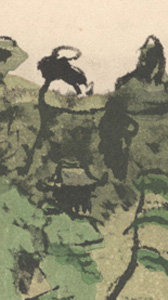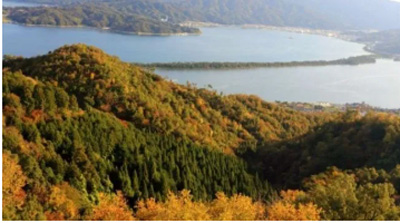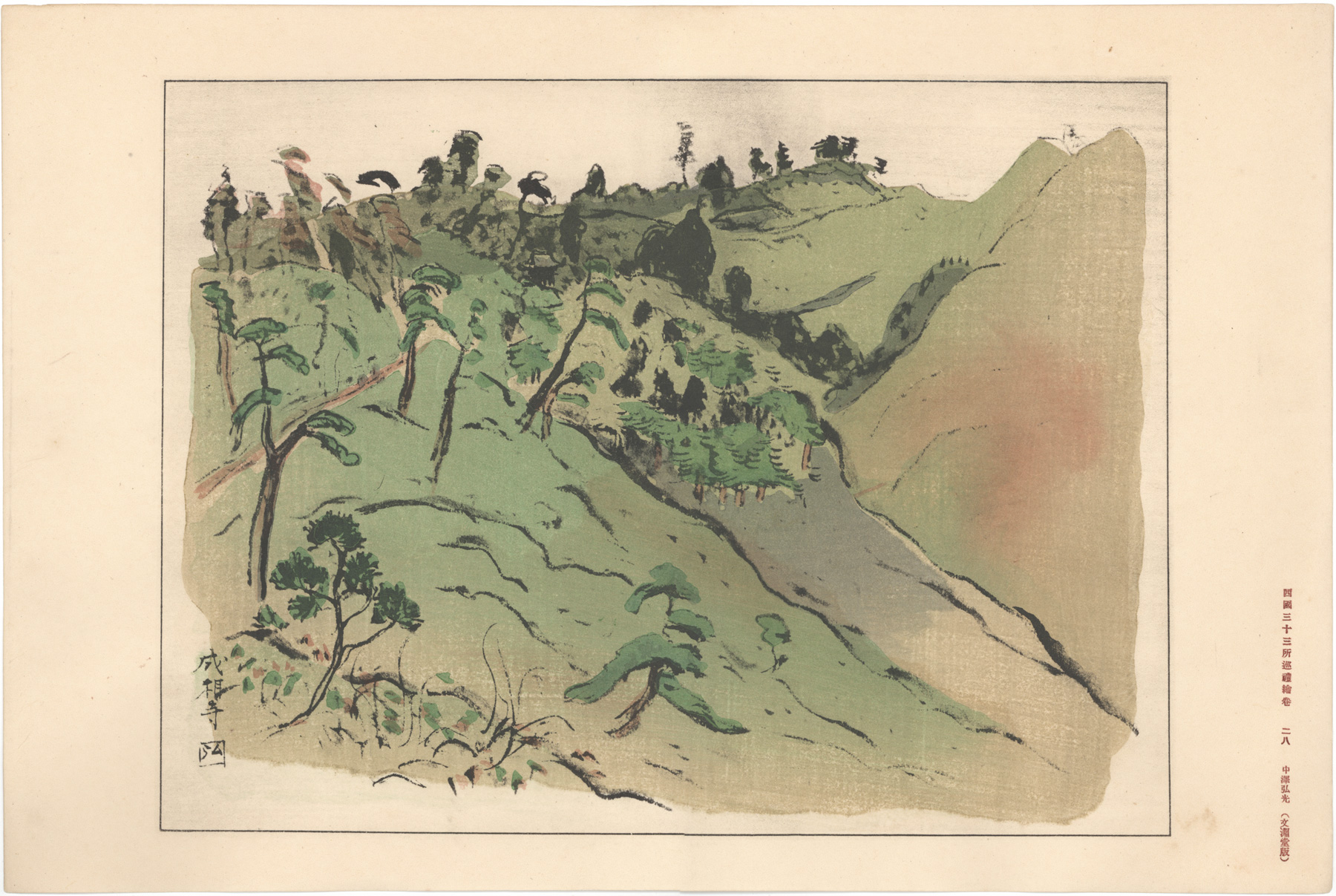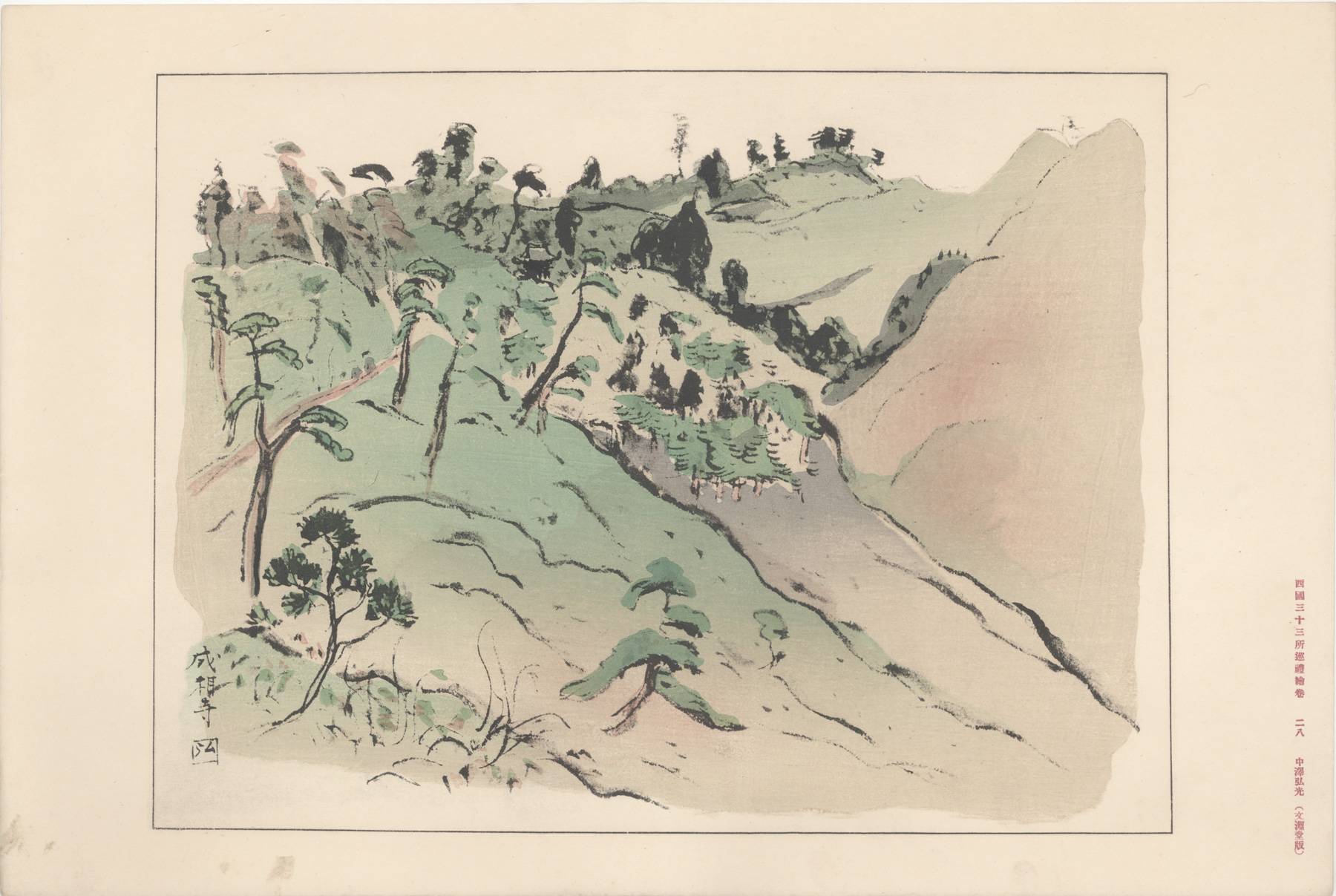About This Print
 | The only trace of Nariai-ji in this print is a single small temple structure (possibly the temple gate) in the center top of the print (see detail left). The temple, located in the far north end of Kyoto, boasts fine views of the Amanohashidate Sandbar, a subject of print number 36 in this portfolio. The orange blush on the right side of this print suggest the beginning of fall colors. A view of Amanohashidate in autumn from the temple image source: Website of Kansai Travel Guide https://2ponderful.com/shrines-and-temples/nariai-ji-temple-kyoto/ |
Nariai-ji is the 28th temple along the Saigoku Kannon Pilgrimage.
On December 1923, only a few months after the Great Kantō Earthquake devastated the Tokyo area, Nakazawa along with his two friends, the poet Ishikura Suiyō and the artist Akatsuka Chūichi, began their pilgrimage to the thirty-three temples comprising the Saigoku Kannon Pilgrimage, taking seventy-eight days to complete the route.
For more information on their pilgrimage see the article Nakazawa Hiromitsu - Picture Album of the Thirty-Three Pilgrimage Places of the Western Provinces.
Sources: Website of Kansai Odyssey http://kansai-odyssey.com/nariai-ji-temple-and-the-beautiful-kannon/
The temple was founded in 704 by Emperor Monmu (683-707) on the top of Mount Tsuzumigatake, but was moved down to its current location after a landslide in 1400. According to legend, as told in the 12th-century Konjyaku Monogatari, "the monk Shinō went deep in to the forest to practice his devotion in solitude. However, there wasn’t much food in the forest and Shinō gradually began to starve. One day, he prayed to his statue of Kannon for food. Shortly thereafter, he found a dead boar. Though he was a monk and therefore it was forbidden to eat meat, Shinō ate one of the boar’s thighs, concluding that life is too precious to waste. After he finished his meal, he looked over at this kannon statue. The statue’s right thigh was missing and he was covered in sawdust! Shinō realized that the statue had turned itself into boar in order to save his life."
The main enshrined image (honzon) of the temple is the bodhisattva Shō Kannon.
The Saigoku Kannon Pilgrimage (Saigoku sanjūsansho junrei)
Sources: website of cultural anthropologist Martin Gray http://www.taleofgenji.org/saigoku_pilgrimage.html and "Buddhist Pilgrim/Buddhist Exile: Old and New Images of Retired Emperor Kazan in the Saigoku Kannon Temple Guidebooks," Mark MacWilliams, appearing in History of Religions, May, 1995, Vol. 34, No. 4, The University of Chicago Press, p. 303-328.
Japan's most famous pilgrimage, originating in the 11th century, encompasses 33 Buddhist temples in Western Japan (Kansai region) dedicated to Kannon (bodhisattva Avalokitasvara), the Bodhisattva of Compassion, who hears the cries of the world and assists anyone in distress.
The 33 temples on the approximately 1,000 kilometer pilgrimage route correspond to Kannon's ability to take on 33 different forms. One hundred thousand pilgrims navigate the route in its entirety or part each year.
Note: For a listing of all 33 temples go to https://en.wikipedia.org/wiki/Saigoku_Kannon_Pilgrimage. To access an interactive map of the route and its temples go to https://www.thetempleguy.org/p/saigoku-33-kannon-route.html and scroll down towards the bottom of the page.
About the "Picture Album of the Thirty-Three Pilgrimage Places of the Western Provinces"
First issued in 1925 and reprinted in 1946, the 1925 album contains 58 prints and the 1946 album 59 prints. For detailed discussion of the two editions and additional information on the Saigoku Kannon Pilgrimage see this site's article Nakazawa Hiromitsu - Picture Album of the Thirty-Three Pilgrimage Places of the Western Provinces.
Print Details
IHL Catalog
#2321 and #2413.36 Title or Description Nariai-ji (temple 28)
成相寺 (二十八) Series Picture Album of the Thirty-Three Pilgrimage Places of the Western Provinces
西国三十三所巡礼画巻 Saigoku sanjūsansho junrei gakan Artist Nakazawa Hiromitsu (1874-1964)
Signature  中澤弘光 [Nakazawa Hiromitsu] printed in lower right margin as shown left
中澤弘光 [Nakazawa Hiromitsu] printed in lower right margin as shown left Seal of the artist  弘 Hiro
弘 Hiro Publication Date Published September 28, 1925 大正十四年九月十八日発行 as printed in the 1925 album's colophon (see Album Box with Print of Kannon IHL Cat. #2413).
Note: an earlier date of June 15, 1925 大正十四年六月十五日 appears in the right margin of the print titled Matsunoo-dera [IHL Cat. #2245], the only print in the 1925 album which carries a date. This earlier date, however, is the date that the censor's approval was obtained, as further explained on this site's web page for Matsunoo-dera, rather than the publishing date. Publisher 發行者 金尾種次郎 publisher Kanao Tanejirō
發兌元 金尾文淵堂 publishing house Kanao Bun'endō
 文淵堂版 [Bun'endō han] printed in lower right margin as shown left
文淵堂版 [Bun'endō han] printed in lower right margin as shown left
Carver Okada Seijirō 岡田清次郎
Note: the album's colophon (see Album Box with Print of Kannon IHL Cat. 2413) lists two carvers, the above well-known Okada Seijirō and 大倉藤太郎, possibly read Okura Tōtarō, who I can find no information on. Printer Nishimura Kumakichi 西村熊吉
Note: the album's colophon (see Album Box with Print of Kannon IHL Cat. 2413) lists three printers, the above well-known Nishmura Kumakichi; 山県秀助, possibly read Yamagata Hidesuki, who I can find no information on, and 松本兄弟堂, a company founded in Osaka by Matsumoto Kisaburō 松本喜三郎 in 1923, which I believe did the letterpress printing. Impression IHL Cat. #2321 and #2413.36: excellent
Colors IHL Cat. #2321 and #2413.36: excellent Condition IHL Cat. #2321 and #2413.36: good - spots of soiling lower left margin Genre shin hanga; shasei kikō (sketch-tour) Miscellaneous  temple/print number 28 appearing in the right margin of the 1925 release
temple/print number 28 appearing in the right margin of the 1925 release Format horizontal oban
H x W Paper
10 1/16 x 15 1/4 in. (25.6 x 38.7 cm)
H x W Image
8 9/16 x 11 9/16 in. (21.7 x 29.4 cm) Literature Nakazawa Hiromitsu kenkyū: Hon karano kenshō, Hiromitsu Nakazawa, Mitsunobu Satō, et. al., Mitsui Kōkei, Tokyo, 2006, p. 46-48. Collections This Print
National Diet Library Call Number 寄別7-8-2-5 (1925 album, no images displayed); National Library Board, Singapore BRN:9854371 (entire 1946 album, no images shown); British Library System number: 017018582 (entire 1946 album, no images shown); Harvard Yenching Library HOLLIS number 990082993710203941 (1925 album, no images displayed)
| IHL Catalog | #2321 and #2413.36 |
| Title or Description | Nariai-ji (temple 28) 成相寺 (二十八) |
| Series | Picture Album of the Thirty-Three Pilgrimage Places of the Western Provinces 西国三十三所巡礼画巻 Saigoku sanjūsansho junrei gakan |
| Artist | Nakazawa Hiromitsu (1874-1964) |
| Signature |  |
| Seal of the artist |  |
| Publication Date | Published September 28, 1925 大正十四年九月十八日発行 as printed in the 1925 album's colophon (see Album Box with Print of Kannon IHL Cat. #2413). Note: an earlier date of June 15, 1925 大正十四年六月十五日 appears in the right margin of the print titled Matsunoo-dera [IHL Cat. #2245], the only print in the 1925 album which carries a date. This earlier date, however, is the date that the censor's approval was obtained, as further explained on this site's web page for Matsunoo-dera, rather than the publishing date. |
| Publisher | 發行者 金尾種次郎 publisher Kanao Tanejirō 發兌元 金尾文淵堂 publishing house Kanao Bun'endō  |
| Carver | Okada Seijirō 岡田清次郎 Note: the album's colophon (see Album Box with Print of Kannon IHL Cat. 2413) lists two carvers, the above well-known Okada Seijirō and 大倉藤太郎, possibly read Okura Tōtarō, who I can find no information on. |
| Printer | Nishimura Kumakichi 西村熊吉 Note: the album's colophon (see Album Box with Print of Kannon IHL Cat. 2413) lists three printers, the above well-known Nishmura Kumakichi; 山県秀助, possibly read Yamagata Hidesuki, who I can find no information on, and 松本兄弟堂, a company founded in Osaka by Matsumoto Kisaburō 松本喜三郎 in 1923, which I believe did the letterpress printing. |
| Impression | IHL Cat. #2321 and #2413.36: excellent |
| Colors | IHL Cat. #2321 and #2413.36: excellent |
| Condition | IHL Cat. #2321 and #2413.36: good - spots of soiling lower left margin |
| Genre | shin hanga; shasei kikō (sketch-tour) |
| Miscellaneous |  |
| Format | horizontal oban |
| H x W Paper | 10 1/16 x 15 1/4 in. (25.6 x 38.7 cm) |
| H x W Image | 8 9/16 x 11 9/16 in. (21.7 x 29.4 cm) |
| Literature | Nakazawa Hiromitsu kenkyū: Hon karano kenshō, Hiromitsu Nakazawa, Mitsunobu Satō, et. al., Mitsui Kōkei, Tokyo, 2006, p. 46-48. |
| Collections This Print | National Diet Library Call Number 寄別7-8-2-5 (1925 album, no images displayed); National Library Board, Singapore BRN:9854371 (entire 1946 album, no images shown); British Library System number: 017018582 (entire 1946 album, no images shown); Harvard Yenching Library HOLLIS number 990082993710203941 (1925 album, no images displayed) |
last revision:
1/27/2021
12/20/2020
7/5/2020 created



